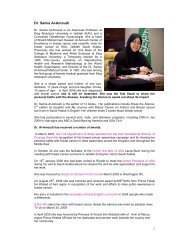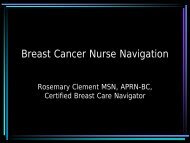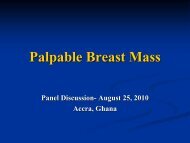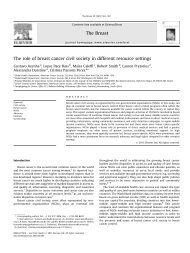3.3-Systemic therapy (Eniu) - Breast Health Global Initiative
3.3-Systemic therapy (Eniu) - Breast Health Global Initiative
3.3-Systemic therapy (Eniu) - Breast Health Global Initiative
Create successful ePaper yourself
Turn your PDF publications into a flip-book with our unique Google optimized e-Paper software.
<strong>Systemic</strong> chemo<strong>therapy</strong> ofbreast cancer:adjuvant and neoadjuvantAlexandru <strong>Eniu</strong>, MD, PhDMedical OncologistDepartment of <strong>Breast</strong> TumorsCancer Institute Ion ChiricuţăCluj-Napoca, Romania
Bernard Fisher- surgeon• “<strong>Breast</strong> cancer is asystemic diseaseinvolving a complexspectrum of hosttumorinteractions […]variations in effectivelocoregional treatmentare unlikely to affectsurvival substantially.”
Effect of chemo<strong>therapy</strong>:average 15 years results ( n=14 250)EBCTCG overview, Lancet 2005 May;365(9472):1687-717
Chemo<strong>therapy</strong>Basic Principles• Greatest efficacy against cycling cells• ↑ growth fraction = ↑ chemosensitivity– neoplastic cells– gastrointestinal mucosa– bone marrow• ↓ growth fraction = ↓ chemosensitivity– plateau phase of growth– cells in G 0
Chemo<strong>therapy</strong>Basic PrinciplesPharmacologic principles• therapeutic index– ratio of toxic dose toeffective antitumor dose– optimal dose balances tumorvs. host toxicity– body surface area vs. bodyweight dosing
Chemo<strong>therapy</strong> SafetyDrug Reconstitution
When to use chemo<strong>therapy</strong>?• Adjuvant chemo<strong>therapy</strong>:– after complete removal of all tumor– for patients at risk for distant metastases– goal: eradication of micrometastases• Neoadjuvant chemo<strong>therapy</strong>:– before local treatment, to facilitate surgery– goal: treatment of primary tu and micromets– excellent research opportunities- in vivo test• Palliative chemo<strong>therapy</strong>:– for metastatic or inoperable tumors– goal: palliate, improve QoL, prolong survival
Contraindications of chemo<strong>therapy</strong>1. Previous extensive squelletal radio<strong>therapy</strong>2. Unrecovered myelosupression (N< 1500/mm3)3. Diffuse bone & liver metastases4. Renal failure5. Anemia
EVALUATION CRITERIA OF PERFORMANCE INDEXPI Disease signs Decreased effort capacityWeightlossFatigue Walking PersonalhygieneWork01< 5%lowlowlow25 – 10%mediummediumlowmedium3> 10%severeseveremediumsevere4severe0 = Able to carry on normal activities as before , no restrictions1 = Restriction in difficult activities, but ambulatory and capable tocarry on daily activities (e.g. office work, housekeeping)2 = Ambulatory and capable of self care, but incapable to work . Hespends less than 50% of day time in bed or armchair3 = Capable of limited self care. The patient spends more than 50% daytime in bed or armchair4 = Bedridden, the patient can not take care of personal hygiene.
Therapy checklist: chemo<strong>therapy</strong>Strengths Weaknesses Required Resources• Establishedrole in thetreatmentof womenwithinvasivebreastcancer• Costly in manyinstances• Absolute benefitsdecrease withincreasing age• Requires achemo<strong>therapy</strong>experiencedhealthcare teamAnderson, BO et al, Cancer 113:S8, 2221-2243, 2008Laboratory facilities• Monitor CBC and chemistry• Blood bankPharmacy services• Compound the drugs• Antiemetics• Prophylactic and side effectmanagement drugsPhysical facilities to administerintravenous chemotherapeutic drugsMedical services to monitor and managethe toxicities of treatment• Microbiology and general laboratoryfacilities• Hydration facilities• Transfusion services for RBC, platelets• Broad-spectrum antibiotics• Growth factors• Pulmonary and cardiac monitoring
Therapy checklist: chemo<strong>therapy</strong>Regimen Strengths WeaknessesClassical(oral) CMFAnthracycline-basedchemo<strong>therapy</strong>(e.g., AC, EC,or FAC)Taxanes•Equivalent to regimens ofanthracycline-based chemo<strong>therapy</strong>in certain situations•An effective and less expensiveadjuvant chemo<strong>therapy</strong> regimen•Superior overall to CMFchemo<strong>therapy</strong> in unselectedpatients•Generally a short course of<strong>therapy</strong>•Doxorubicin generally lessexpensive than epirubicin•Taxane chemo<strong>therapy</strong> may addbenefit to anthracycline-basedchemo<strong>therapy</strong> in some patients•6 month treatment duration•Multiple infusions•Variable patient compliance•Potential cardiac toxicity•Costly•4-6 months treatment duration•Expensive•Additional toxicity(neurologic, bone marrow)Anderson, BO et al, Cancer 113:S8, 2221-2243, 2008
Treatment resource allocationStage II breast cancerAnderson, BO et al, Cancer 113:S8, 2221-2243, 2008
• CMF• EC• ACChemo<strong>therapy</strong> regimens– Cyclophosphamide 100 mg po d1-14– Methotrexate 40 mg/mp iv d 1+8 q28z– 5-Fluorouracil 600/mp iv d 1+8– Farmorubicin 100mg/mp iv d 1 q21z– Cyclophosphamide 600 mg/mp iv d 1– Doxorubicin 60 mg/mp iv d 1 q21z– Cyclophosphamide 600 mg/mp d 1• Docetaxel 100mg/mp iv z1 q 21 z• Paclitaxel 80mg/mp qw for 12 w
Dose is Important for AdjuvantChemo<strong>therapy</strong> for Early-Stage <strong>Breast</strong> CancerThe Milan Study: Relapse-Free and Overall Survival With CMF20-year follow-up (N = 386)Probability ofRelapse-Free Survival (%)10080604020005 10 15 20Probability ofOverall Survival (%)100Adapted from: Bonadonna G et al. N Engl J Med. 1995;332:901-906.8060402000Years After MastectomyOptimal Dose (%)≥85 (n = 42)65-84 (n = 94)
Primary chemo<strong>therapy</strong> for LABCWhat we know?• Initially used to shrink inoperable cancers• Not formally compared to local <strong>therapy</strong> alone…• Improvements in survival with combinedmodality established it as STANDARD OFCARE• Few studies conducted specifically in LABC• Heterogeneity (definition, regimens,endpoints)• Standard regimens are Anthracycline-based• Taxanes were evaluated in newer studies
The NSABP dataOPERABLE breast cancercCRpCRB-18 36% 13%4 x ACn=1506B-27 60% 26%4 x AC+4x Docetaxeln=2411Wolmark, J Nat Cancer Inst Monogr. 2001, 30:96; Bear, J Clin Oncol 2006,24:2019
The MD Anderson experience- LABCpCRPredictiveKuerer 12% ER-, G34 x FACn=372Green (n=258)4x q3wP+ 15,7% ER-, PR-4 x FAC12 x wP+ 28,2%4 x FACKuerer, J Clin Oncol,1999; Green, J Clin Oncol 2005; Hennessy, J Clin Oncol 2005
Treatment resource allocationLocally advanced breast cancerAnderson, BO et al, Cancer 113:S8, 2221-2243, 2008
Evaluation prior to primary systemic<strong>therapy</strong> for LABC• Clinical examination (schematic represent):– Clinical size of tumor ( measure it!)– Skin changes: erythema, edema, ulceration, anddimpling– Lymph node status ( measure!)• Photo documentation (inflammatory, T4’s…)• Elicitation of symptoms suggestive for distantmetastasis• Natural history of the disease (rapid growingversus neglected tumor…)
Evaluation prior to primary systemic<strong>therapy</strong> for LABC (2)• Pathology: CORE BIOPSY /FNA– (grade, invasion, RE, RP and Her2 (?))• Adequate breast imaging: extent of disease– Mammography– Ultrasound for T and N• Staging: X-ray, blood tests (CBC, liver, AP)– optional: bone scan, abdominal CT
Response assessment• Clinical exam at each cycle (T, N)-> to identify progression• Post <strong>therapy</strong>: 2 weeks after last cycle of chemo– Clinical exam: notoriously inaccurate!– Mammography / ultrasound ( Chagpar, Ann Surg, 2006)Clinicalutility?
Surgery after primary chemo<strong>therapy</strong>• Surgery: 3-6 w after chemo– WBC nadir : 1,5-2 weeks– N>1500, Plt >50 000• Type of surgery– MRM for all LABC ?!• Criteria for breast conservation ( Singletary, CancerTreat Res 1997)– Resolution of skin edema– Residual tumor size MRM– No evidence of multicentricity-> MRM
<strong>Systemic</strong> treatment after surgery• Hormone receptor positive -> hormone <strong>therapy</strong>• (Her2 positive -> adjuvant trastuzumab )• Further chemo<strong>therapy</strong> ?Would more chemo<strong>therapy</strong> be better?Yes, tumor is really sensitive to chemoNo, prognosis is already very good• Many (all?) patients had anthra+alkylator and taxanes• No data to suggest further benefit from chemo• In the absence of trial data, further chemo<strong>therapy</strong>should not be administered if anthra and taxaneshave been already usedWould more chemo<strong>therapy</strong> be better?Yes, high risk imposes further treatmentNo, tumor does not respond to chemo
Conclusions -Neoadjuvantchemo<strong>therapy</strong>• Standard primary chemo<strong>therapy</strong> for LABCshould include an anthracycline (FEC, AC, EC…)• Optimal duration is unknown –4 -8 cycles• Dose-intense anthracycline regimen does notimprove outcome (metronomic schedule may)• Addition of taxanes improved outcomes but notDFS or S ( sequential, not concurrent ?)• 4 cycles of Anthra plus 4 cycles of docetaxel or12 w of weekly paclitaxel, before surgery
Treatment resource allocationMetastatic breast cancerAnderson, BO et al, Cancer 113:S8, 2221-2243, 2008
ASSESMENT OF TREATMENTRESPONSEWHO, bidimensional measurements-Complete remission (disappearance of allsymptoms & signs for at least 1 month)-Partial remission (reduction >50%)-Stable disease (reduction
RECIST• CR (complete response) = disappearance ofall target lesions• PR (partial response) = 30% decrease inthe sum of the longest diameter of targetlesions• PD (progressive disease) = 20% increase inthe sum of the longest diameter of targetlesions• SD (stable disease) = small changes thatdo not meet above criteria
Response evaluationPatient ABaseline Week 12
Physical Well Being andSymptomsFunctional ActivitiesStrength/FatigueSleep and RestOverall Physical <strong>Health</strong>FertilityPainSocial Well BeingFamily DistressRoles and RelationshipsAffection/Sexual FunctionAppearanceEnjoymentIsolationFinancesWorkQuality of LifeQoLFerrell, BR and Grant, M. City of HopeBeckman Research Institute(2004)Psychological Well BeingControlAnxietyDepressionEnjoyment/LeisureFear of RecurrenceCognition/AttentionDistress of Diagnosis and Controlof TreatmentSpiritual Well BeingMeaning of IllnessReligiosityTranscendenceHopeUncertaintyInner Strength
Major Therapeutic Approaches inHormone-Dependent <strong>Breast</strong> CancerEproductionReduce Estrogen- Ovarian FunctionSuppression (Pre)- Aromatase Inhibitors(Post)EERBlock Estrogen-TAMOXIFEN (Pre or Post)- SERMs
Menopausal status• Women over 60 years of age• Bilateral ooforectomy• Women over 45 years with spontaneouscessation of menses for more than 12 months• Women over 45 years with cessation of mensesafter chemo<strong>therapy</strong> AND FSH and estradiolvalues in the menopausal range• For patient under 45 years of age,postchemo<strong>therapy</strong> amenorheea is acontraindication for AI*! ** Smith et al. J Clin Oncol. 24:2444-2447. © 2006
Effect of TAMOXIFEN:average 15 years results ( n=46975)EBCTCG overview, Lancet 2005 May;365(9472):1687-717
Effect of ovarian ablation:average 15 years results ( n=8 000)EBCTCG overview, Lancet 2005 May;365(9472):1687-717
Therapy checklist: endocrine <strong>therapy</strong>Strengths Weaknesses Required Resources•Adjuvant endocrine<strong>therapy</strong> in women withER+ and/or PR+ or -unknown receptorssubstantially reduces therisks of disease recurrenceand death•Limited toxicity•Easily administered bygeneral practitioner orsurgeon•Absolute benefits inadjuvant setting increasewith increasing risk ofrecurrence•Optimally requiresavailability of ER andPR determination•Benefits are limited inlow-risk breast cancer•Compliance varies•Need ability to managerare but potentiallyserious side effects•Pathology*•Tumor steroid hormonereceptor content•Tumor histologic grade•Stage of disease(biochemistry andradiological investigation)•Resources for diagnosis andmanagement of toxicities•Pharmacy/drug distributionAnderson, BO et al, Cancer 113:S8, 2221-2243, 2008
Therapy checklist: ovarian ablationRegimen Strengths WeaknessesOvarianablation(medical,surgical,radio<strong>therapy</strong>)•Effective for pre-menopausal women with ER+and/or PR+ or -unknown receptors:•Combined medical oophorectomy (LHRH +tamoxifen) is equivalent to CMF chemo<strong>therapy</strong>•Oophorectomy (surgery or radiation) plustamoxifen may be considered an appropriateadjuvant endocrine <strong>therapy</strong>•Surgical and radiation induced ovarian ablationis likely to be cost-effective compared withchemo<strong>therapy</strong> alone•Long-term adverseeffects of estrogendeprivation inyoung women•High cost of LH-RH agonistsAnderson, BO et al, Cancer 113:S8, 2221-2243, 2008
Therapy checklist: tamoxifen and AIRegimen Strengths WeaknessesTamoxifen •Improves disease-free and overall survival in all •Toxicityage groups and nodal subsets and with or •Hot flasheswithout chemo<strong>therapy</strong> in ER+ and/or PR+ or – •Thromboembolic diseaseunknown receptors disease•Endometrial carcinoma•Reduces risk of second, contralateral breast ca •Rare ocular toxicities•Maintains bone mineral density inpostmenopausal women•Inexpensive•Known long-term toxicity profileAromataseinhibitors(AIs)•In postmenopausal women with ER+ and/orPR+ or -unknown resected breast cancer:•Adjuvant AIs are superior to tamoxifen•Sequential AI following 2–3 years of tamoxifenis superior to tamoxifen alone•Extended AI <strong>therapy</strong> following 5 years oftamoxifen is superior to 5 years of tamoxifen•No increase in thromboembolic events orendometrial cancerAnderson, BO et al, Cancer 113:S8, 2221-2243, 2008•Absolute differencebetween AIs and tamoxifenalone in terms of diseasefreesurvival is small•No clear impact onsurvival•Substantially higher costcompared with tamoxifen•Toxicity: increased risk ofbone fracture, arthralgias
Factors driving treatmentdecisionsTUMORBIOLOGYFear ofsymptomsChance of responseto <strong>therapy</strong>Personal issuesRisk of deathPatientspreferenceRisk of progressivediseaseToxicity dataImpact on QoL
Conclusions• Important advances have been achieved inthe management of breast cancer• Mortality has decreased in developedcountries• Resource constraints impose alterations ofthe multidisciplinary pattern of care• Build a strategy for improving care• Incremental, step-by-step allocation• Optimal care to all is the ultimate goal











